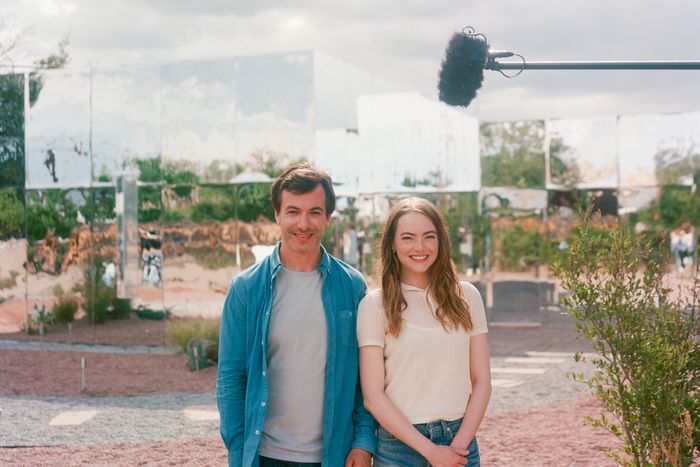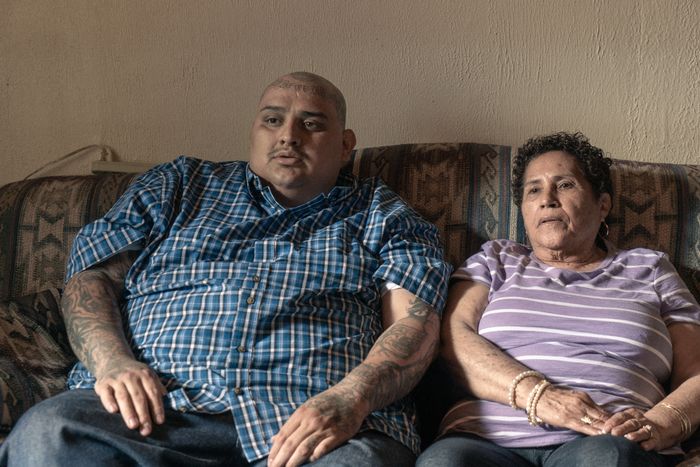
In the opening shot of The Curse, Nathan Fielder and Benny Safdie’s A24 Showtime series, the camera zooms in through the window of a house with flaking green stucco and a faded metal awning. A man (shaved head, tattooed) is seated next to his mother, who has cancer, and describes his fruitless search for full-time work. Once inside, the camera pulls back to reveal that the man, Fernando, is being interviewed on-camera by a couple, HGTV hosts Whitney and Asher Siegel (Emma Stone and Fielder), overseen by a director dripping in turquoise rings and exuberant, gonzo irreverence. “Nothing,” Fernando says. “A day here, a day there, but no work.” Whitney reveals that she and Asher have secured Fernando full-time employment. When his mother’s response isn’t emotional enough for the director, he tips capfuls of bottled water into her eyes until it spills down her cheeks like tears.
“The very first scene, the way the character speaks, immediately: It was a person from Española,” says Dennis Ortiz, a 45-year-old from the Española Valley who caught The Curse by chance late one night on TV. “His dialect and cadence is unmistakable.” For those who know it, the way Fernando pronounces “nothing” — the o sounding more like a u, the lilt of his speech — is recognizable as a northern New Mexico accent. Ortiz recognized the character types too: “A lot of people do what the Siegels are trying to achieve — spend money on trying to have a good cause in towns like Española,” he says. “They picked up on all the clichés I grew up with.”
Since the late 1930s, Española has served as a backdrop for film and television productions looking to mimic the wide-open skies and dramatic landscapes of Texas or Wyoming. In The Curse, Española plays itself for the first time onscreen. As aspiring reality-TV hosts/entrepreneurs, Whitney and Asher launch a passive housing business in their adopted hometown with the promise to both reflect and revitalize the community. The Siegels are quickly legible as a particular type of privileged millennial, and The Curse delights in taking their antics to extremes. Whitney wants to find the perfect buyer for the house featured on the show — someone who will “embody the values of the community” — and Asher’s childhood friend Dougie (Safdie) is a down-on-his-luck alcoholic willing to direct their HGTV pilot. One afternoon, Asher is filmed in a parking lot giving a young girl (Hikmah Warsame) a hundred-dollar bill, but after the moment is captured on-camera, he takes back the money. The little girl, Nala, curses him, a moment that haunts the Siegels and their production through ten increasingly surreal, unsettling episodes.
Española, a town of approximately 10,000 people surrounded by mountains and tribal land at the confluence of the Rio Grande and Chama Rivers, has a complex history of poverty, substance use, and violence, in addition to a cultural distinction and scenic beauty that the series, for all its weirdness, attempts to acknowledge. Ever since The Curse premiered in October, and especially since its finale last month, locals have been wrestling with its depiction of their home and whether it does justice to life in Española. “You’re showing the physical bodies and the landscape of a place that’s gone through generations of colonization,” says Maryssa Rose Chavez, a 26-year-old visual artist born in the Valley who now lives in Austin. “It’s a fine line to walk.”
Españolans tend to be wary of how their town is portrayed, dating back — at least — to a 1984 New York Times article that points out Española’s “relative invisibility” between Santa Fe and Taos, arguing that if the town is known, it’s for low-rider jokes. “We’re resistant to people pointing out the problems, especially if they don’t live here,” says Samuel LeDoux, a 32-year-old who auditioned to play Fernando on The Curse and is running for city council. “You see some stereotypes, like in the Fernando character, he’s a big tough guy, kind of gangsterish. The fact is, people from Española accomplish big things; one of our current district judges is from Española. We have a lot of accomplished, educated people — that’s not ever really showcased or highlighted.”
Some residents see The Curse as continued exploitation. On a December NextDoor post about the show, a user wrote, “I think there is a story to be told about the impact of Anglos on the area, but clearly these guys aren’t the ones to tell it … They are so far from appreciating the beauty, history and culture of this place.” Film and television production is big business in New Mexico and creates jobs, but recent data shows the state is losing money on film tax incentives. If one of the poorest communities in one of the poorest states is not benefiting financially from projects coming to the area, is that just more exploitation, especially if they have no control over how they’re portrayed? One NextDoor thread questioned why the neighboring Pueblo in the series was given an alias while the town was not. “Now we are ‘cursed’ for sure. They don’t only film it here, they use our town’s real name. Well, maybe we should sue,” wrote a neighbor.
For Anna Martinez, 45, it was the characterization of Nala and her family that rang false. “There’s a lot of brown people in the Valley,” she explains. “There’s not that many Black people. When I saw that little girl do the curse, I’m like, What’s this about? Why would you have this little girl pull a curse?” Julie Bennett, a 68-year-old resident originally from suburban New York who’s lived in the area since the early ’80s, echoed that she’s rarely seen Black people on the street in Española, an underrepresented demographic in the area in general. (According to the 2020 Census, Black and African American people comprise one percent of the population in Española.)
Many viewers felt the series was more precise when portraying Native concerns and voices. A24 hired a local consulting producer, Ashley Browning (Pojoaque, Santa Clara), whose knowledge provided moments of humor and specificity for the show, as when Whitney mixes up Tewa and Tiwa — related but distinct linguistic and cultural groups that each include different Pueblos. When Asher learns Nala and her family are living in a house he owns on paper, the dynamic felt uncomfortably familiar for Chavez. After neighbors from Seattle moved next door to Chavez’s mother, she was questioned about whether or not the easement she lives on and believes she owns was actually hers. Chavez also saw aspects of herself and people she loves in the character of Cara (Nizhonniya Luxi Austin), an Indigenous artist Whitney is desperate to impress. “Cara very blatantly tells them how it is, like a lot of people in my community,” says Chavez. “Indigenous women, matriarchs, Chicana women — we’re gonna tell it to you straight. She’s like, You’re uncomfortable, girl, but I am who I am. It’s relatable as a young artist.”
Cristian Madrid-Estrada, the 24-year-old CEO of the Pathways Homeless Shelter, which The Curse used as a shooting location, had a good experience with production, and the show employed several Pathways clients as extras and day workers. Within his community, Madrid-Estrada says reactions have been split. Some residents “have a great sense of pride in the community and are protective around the portrayal of its perceived flaws,” he says. “Other folks felt it was very honest about the ugly truth of the hardships this community faces.” When the show wrapped, Madrid-Estrada, who has a cameo, said “Miss Emma Stone” and Fielder each made $20,000 donations to Pathways. In an unfortunate real-life parallel, two other filming locations, apartment complexes that served as sets for run-down buildings in Santa Fe owned by Whitney’s slumlord parents, were later seized and condemned.
Gentrification, perhaps the theme of the show, is a problem in the town, but not as much as other places in the state, says LeDoux. “There’s a disconnect between the issues Española faces and what the show is trying to comment on,” he says. While housing costs are rising, LeDoux says it’s not primarily due to wealthy outsiders moving to Española, but supply failing to meet demand. “Families who’ve lived in Santa Fe for generations are leaving for Española because they can’t afford to be in Santa Fe anymore.”
While The Curse satirizes the behavior of Whitney, Asher, and Dougie, to some, the people and places of Española come across as incidental, props and backdrops used in service of the show’s broad points about gentrification. “Some people have a hard time relating to the humor because of the harsh contrast between the gritty reality and the goofiness of the characters,” suggests LeDoux. “As someone who works in the arts, I’m pretty well versed,” Chavez says. “But I still felt like, Wait, what are they making fun of here?”
Joey Montoya, a 34-year-old who grew up in Española and now lives 22 miles to the south in Santa Fe, felt the satire was incisive and accurate. “What they’re showing with Asher and Whitney is very real,” he says. “Gentrification and people coming in with their own ideas without asking the locals what’s best for them.” Adds Melissa Chambers, a 59-year-old Santa Fe–based actor who plays Rachael Ray’s field producer in the finale: “I know those people, Emma Stone’s parents. I see them at dinner parties and recognize them as people who own businesses and properties in Santa Fe. It can be uncomfortable to watch, but I think it’s important to feel uncomfortable sometimes.” For some, the discomfort felt personal. “I’m very aware of how my background as a white female Jewish construction worker has given me a different perspective and also given me entitlement,” says Bennett, who raised two sons here with her husband. “The show succeeded in that it made me self-conscious. But I also don’t think it reflects my commitment to this area. I don’t want accolades for talking to people who aren’t like me. It’s how I live in my world.”
Most locals agree that The Curse’s intended audience is not Españolans themselves. LeDoux says many people in the Valley — including some local cast and crew — aren’t watching the show due to the financial barriers of premium subscription services. Other residents simply aren’t aware of it. Montoya doesn’t think anyone in his family watched. “It’s odd and not for everybody,” he says. “It requires an appreciation for film as art. I don’t know if my parents would get it. I’ll share it with my siblings eventually.”
On the show, Whitney and Asher’s time spent grappling with their privilege takes them to wildly different places. While Whitney becomes a mother, Asher literally leaves the stratosphere, either because he’s transcended this earthly realm or because he could never truly belong to Española, depending on whom you ask. “All of the main characters have shame in their lives for whatever reason, and they’re trying to pass it on,” says Ortiz. “That’s why they coupled so well with the people of Española: They don’t have anything to be ashamed of.”




